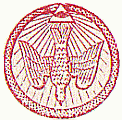Ordo Templi Orientis Phenomenon
Of Booksellers And Other Grand Masters Of The O.T.O.Heinrich Traenker, Aleister Crowley, Henkelkreuzmann, Theodor Reuss, Carl Kellner, Franz Hartmann, Pansophie, Pansophische Loge, Eugen Grosche, Karl Germer, Martha Kuentzel, Henry Heinrich Birven, Spencer Lewis, Charles Jones, Achad, Albin Grau, Arnoldo Krumm-Heller, Collegium Pansophicum, Max Schneider, A.M.O.R.C., Hans Rudolf Hilfiker, Hermann Joseph Metzger, Illuminat, Recnartus, Gerald Yorke, Fraternitas Saturni, Memphis-Misraim C.H. Petersen, Eduard Munninger Medardus, Fraternitas Rosicruciana Antiqua, Martin Erler, AAORRAC Antiquus Arcanus Ordo Rosae Rubeae Aureae Crucis | 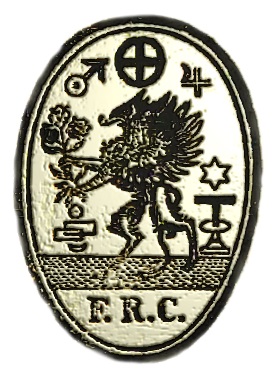 |
Heinrich TränkerAmidst the confused beginnings of Theosophy in Germany, Heinrich Tränker (born August 6th 1880) was working as a publisher and book-seller at the 'Central Theosophical Bookshop' in Leipzig. At the end of the Great War in November 1918, the bookshop was forced into receivership, and Tränker parted from the Leipzig Theosophical group. The following year, he made contact (through Franz Hartmann) by letter with Reuss, [1] and alongside A.A. Otto and Otto William Barth, founded the 'Lotus Society' in Munich, which was mainly concerned with Hartmann's teachings. Hartmann though, did not invest one jot of trust in Tränker by way of return. In 1920-21 Tränker and his wife Helene invented what they called 'Pansophy', and at the same time got hold of an X°-degree O.T.O. warrant for Germany from Reuss, though without having met him. After first choosing the motto 'Tartarus' and "Henkelkreuzmann" (Man of the Ankh), Tränker availed himself of a succession of zoological names: 'Recnartus', 'Greif' (Condor), and 'Garuda' (the bird of wisdom in Buddhism). |
| In 1922 he joined forces with Karl Germer, whom he had first met at Lepzig in early 1919, in the 'Collegium Pansophicum'. Germer worked as an engineering technologist, and financed this lodge's publications; under his motto 'Saturnus' he got at least a theoretical introduction to esoteric matters. Tränker then made contact with Eugen Grosche, who instigated the 'Orient Berlin' Pansophical lodge; its first acting Master was a designer from the UFA film studios, Albin Grau "Pacitius". It is probable that this group was an amalgamation of members from the 'Franz Hartmann Rosicrucian Society', and the 'Heindel Movement', another Rosicrucian grouping [2]. At this time, a number of Theosophical (TS) Society members became followers of Pansophy only with apparent qualms. [3] | 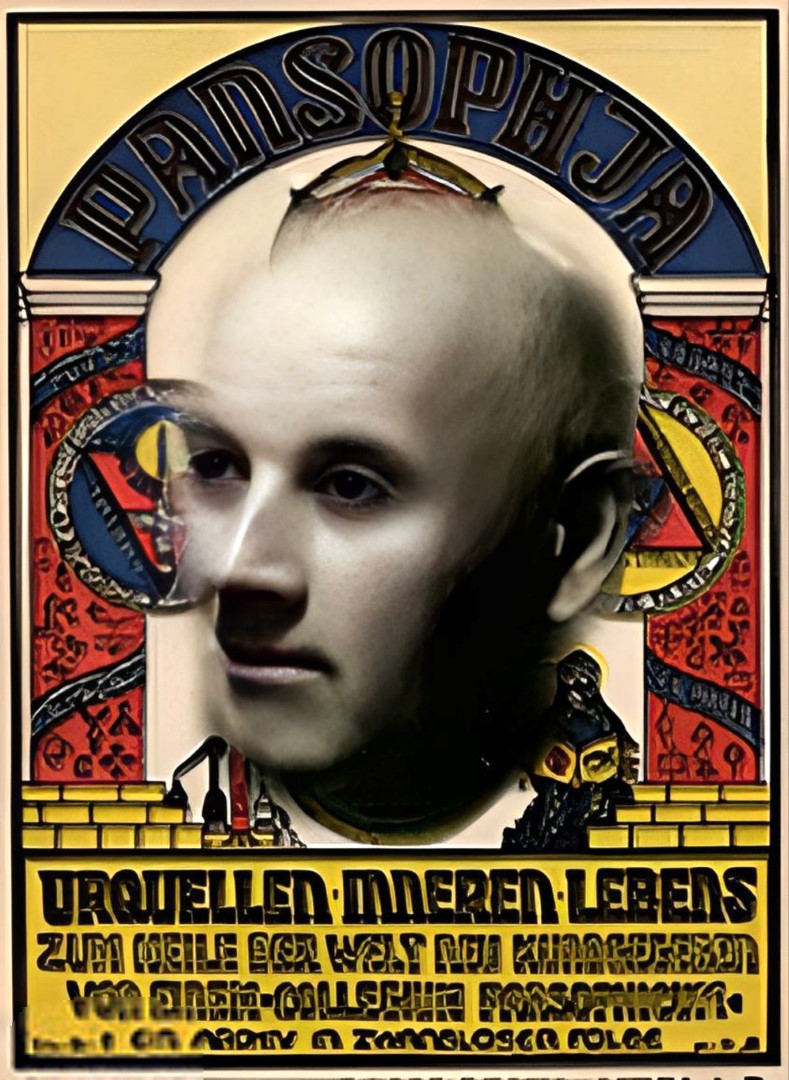
|
|
After Reuss's death in 1923, Tränker gained possession of the Order's records from Reuss's widow, and deposited the material at O.W. Barth's; however Frau Reuss soon turned against him. [4] Tränker dutifully informed C.S. Jones, (alias 'Frater Arctaeon' alias 'OIVVIO' alias 'Parzival' alias 'Achad') the American X°, about his esoteric aspirations. The O.T.O. itself had "no particular value" for him; [5] all he wanted for himself was to be the leader of all organisations behind the scenes. Externally, either Jones or Crowley could function as OHO, and this was the sole reason why Crowley (at the time in Tunis) was invited to visit Germany - or so went the story according to Tränker. "Liber I, the Book of the Zero-Hour", signed by the lodge secretary Eugen Grosche, proclaimed its message of 'pitiless love': "The end is nigh! [...] into this vacuum comes the Law: Do what thou wilt". [6] And so Aleister Crowley as the personification of this Law, arrived at Tränker's house at Hohenleuben in Weida; he was immediately proclaimed world saviour [not OHO], with the agreement and support of Norman Mudd, Leah Hirsig, Dorothy Olsen, Karl Germer, Martha Küntzel, and her lover Otto Gebhardi. [7] Germer did the interpreting for the most part, though it was Max Schneider who translated Crowley's "Book of the Law". Soon attracted to Germer, Crowley made him into a IX° - after all, Germer was paying for his trip to Germany; Crowley also allowed various rude 'Comments to Tränker' to circulate. Why it was Crowley who fell out with Tränker, rather the other way round, when Tränker possessed Reuss's valuable records, remains unresolved. [8] Only Germer and Martha Küntzel stayed loyal to the world saviour; all the others promptly withdrew their votes for Crowley. [9] Rumour had it that Tränker sought an extradition order against Crowley "Therion" from the police, and swore a magical oath against Crowley so that he would be "rendered powerless". Annoyed by this, Albin Grau demanded that Tränker resign as Grand Master of the Pansophical Lodge. But Tränker refused to budge, resulting in a "solemn ceremony of dissolution" for Pansophy in Berlin, then Grau's break with Tränker's O.T.O., while at the same time the Pansophical study-group in Berlin, the 'Fraternitas Saturni' split away from Pansophy. Comments to Heinrich Tränker [10] 1. First draft of a letter from Crowley to Tränker (November 1924): "At present there is no continuously working organisation which can claim an authentic tradition..." Sect. III. It is to be understood clearly that I have no need of historical proofs for myself. [11] For one thing I do not much believe in historiy in any case and for another the proofs which I possess of the authority of the A.·. A.·. and of that tradition which the O.T.O. in a lesser degree claims are entirely convincing. [...]It is my True Will first of all to establish the Law of Thelema & to this end: I wish to obrain control of all existing movements." Relations between myself, Aleister Crowley, and Heinrich Tränker - paragraph C: Section C. "In the Autumn of 1924, my then representative in America (C. Stansfield Jones) wrote to me that he had got in touch with a man called Heinrich Tranker [...] (5) That Tranker derived at least part of his authority fromthe late Theodor Reuss known as Frater Merlin [12] or Frater Peregrinus. (I had known Reuss and understood that he left Germany in consequence of a scandal connected with his Order [O.T.O. "the mutual touching of the phalli as yoga meditation"] [...] He invited me to his house as a guest fo the summer. The main object of this was two-fold; firstly, various Brethren of the Order from many countries were to be invited to meet me there in order to acclaim me as the supreme authority on the planet. [...] The second object was to come to a closer agreement on various obscure points both of theory and practise and to work together at the issue of my instructions as translated by Herr Karl Germer." Section E. "The increasing discomfort of life at Hohenleuben forced us to spend more and more of our time at Mr. Germer's house near Weida." Statement regarding Heinrich Tränker "His conduct was so outrageous that it was necessary to make formel complaint to the police. But though he was not actually imprisoned he only escaped by the skin of his teeth. [13] He has now taken a list of some of the Orders which I represent, from a published volume of mine and proclaims himself to be the 'Grand Master'." [14] Obituary On Karl Germer by H.C. Birven [15] [Part I] "I had already [1924] been in correspondence with Barth, who was an educated man, before I got to know him personally. I do not know the reasons for H. Tränker's arrival in Berlin not long afterwards, where he lived with Barth in a garret not far from the Hallesches Tor. Barth was hard up, he brought me piles of books that I had ordered from him, at bargain prices. After my visits to this garret, I would often walk with Frau Tränker (who was a waitress) a little way up the Friedrichstrasse. She was a not unsympathetic type, and supported the unskilled Tränker by her own work as an author. From various hints I came to understand that their marriage was already in trouble, and this was because they were childless. A little while later when I was living at Berlin-Hermsdorf, I discovered purely by chance that Tränker had managed to find himself an apartment in the same quarter; there I was amazed by his immense library. This would have been at the beginning of the Nazi régime. I remember too that Tränker wrote to his wife's dictation; he couldn't produce anything halfway decent on his own. Things soon changed radically: when I next went to see Tränker on the off-chance, I discovered that his whole library had been swept away [by the Nazis], under pouring rain in six furniture-vans; they hadn't left so much as a scrap of paper or even a pen-nib behind. He had been hauled off, interrogated, and beaten up; he had a black eye. That evening after his interrogation, Tränker came to see me, and told me about the dirty trick he'd had played on him [...] Tränker soon parted from his wife who was still childless, believing it likely that it was she who had denounced him. Tränker then took a much younger woman for his second bride, who bore him many children. Even so, he left her after a number of years, and married a third time - at his invitation, I was one of the two witnesses to this marriage. Later Tränker once again became the owner of a fine collection of books, which had been left to him by his adherents. Though Tränker was fundamentally uneducated, he had an exact knowledge of all his book's titles, and their descriptions in the catalogues; but he was a bibliophile pure and simple, and as such happy. [16] In August 1925 Crowley, who had previously been in Africa, travelled to a meeting Tränker's house in Weida. He followed an invitation from Tränker. Crowley was travelling with a full retinue of his disciples: Dorothy Olsen, Norman Mudd, and Leah Hirsig... On one particular day a "Zeugnis der Suchenden" [or 'Seeker's Testimony'] was written up, which designated Crowley as 'World Teacher'; it was signed by the following persons: Heinrich Tränker, Helene Tränker, Karl Germer, Dorothy Olsen, Norman Mudd, Leah Hirsig, Martha Küntzel, and Otto Gebhardi. However, this "Zeugnis" had no real effect, since the Tränkers (as the financial backers) withdrew their signatures after a few days. On February 24th 1926 Mudd too withdrew, and likewise Leah Hirsig on August 19th 1927. I have seen the written statements of both Mudd and Hirsig to this effect. [17] Despite this, Germer and Martha Küntzel stayed faithful to their Master for the rest of their lives. The Otto Gebhardi only signed as a favour to Frau Küntzel. Dorothy Olsen was a lover of Crowley's for a long time. Also, Germer first made Crowley's acquaintance in 1925." __________________ Tränker parted in 1925 not only from Crowley, but also from his wife; he now maintained that she was not even a member of his Order, and took himself a lover (calling her "mein Schatzi" - "my little treasure" - Sister 'Jehewidah'?) on whom he fathered two children. His wife went to the police over these actions, accusing her ex-husband of "disgusting sexual perversions." [18] Karl Germer took Tränker to court as well, in the hope of recouping some of the money he'd laid out in support of Tränker and his publications, claiming that Tränker "did not invest a Pfennig in Pansophia." [19] Germer had now made a decisive commitment to Crowley's cause, and subsidised him with money for the rest of his life. The aforementioned "'Collegium Pansophicum' was an invention of Tränker's. He used the term partly to bluff other people: he hinted darkly at a body of high Initiates in distant countries whose agent for Germany, if not Europe, he claimed to be. These initiates never revealed themselves to him. The 'C.P.' actually stood for Tränker and myself..." as Germer wrote to Max Schneider on November 8th 1935. Max Schneider was a jeweller who lived in Antwerp "Viator, 687". He was an IX°, thus in possession of Crowley's "Emblems and Modes of Use", a former friend of Tränker's (Tränker got Crowley's address from him), and the co-founder in 1935 - with W.T.Smith - of the 2nd Agapé Lodge in California. Crowley, who had never met this reclusive man [20], wrote to him in June 1934: "I advise strongly against starting O.T.O. until I am personally present. This time it has got to be done correctly right." However, Crowley was never physically present at any Agapé Lodge during his lifetime. Bernhard Beyer (1879-1966), a neurologist who later founded the German 'Quatuor Coronati' Masonic research lodge, was advertised by Tränker's still-extant Pansophie-Verlag as the author of seven-volume "Masonic Museum" in 1925, alongside the Rosicrucian tomes of Franz Hartmann [21]. Tränker resided at Gera in Thuringia amidst what he called his "sylvan solitude". The Gera Pansophical lodge was called 'Zum hütenden Greif' ('The Griffin Gardant'), and its initiation fee was four marks. On the 5th of December 1926, the 'Zur siegenden Morgenröte' ('Triumphant Dawn') lodge was founded at Königsberg. In the journal "Pansophia" ("Central Organ of the Collegium Pansophicum [...] Correspondance journal [...] of the O.T.O."), 'Recnartus' tried in 1928 to lay claim to, and unite under his own jurisdiction as "new, fully legitimate supreme leadership, national Grand Master for Germany", the following organisations: "Ancient and Primitive Scottish Rite of Freemasonry of Germany, Swedenborg Rite of Masonry, Oriental Templar Order, Hermetic Order of the Golden Dawn, The Rite of Misraim 90°, The Oriental Memphis Rite 97°, The ancient & accepted Rite of Heredom, The Hermetic Brotherhood of Light, Fraternitas Rosae Crucis, etc., New Gnostic Church, New Illumninati." [22] Allusions to the Law of Thelema are difficult to be found in all Tränker's writings, apart from isolated and cryptic references to Pan, Babalon, or "the most holy Book" of the Law ("Liber AL"). Nonetheless, he still gave his pupils the same reading list that Crowley delivered to his students in the A.·. A.·. ("Liber XIII"). The grade system of Pansophy had ten degrees. [23] The "sexual mysteries", according to the Thelemic maxim in Reuss's translation "Liebe ist das Gesetz. Liebe unter der Kontrolle des Willens!" ("Love is the Law. Love under the control of the Will!"), were revealed clearly at least in part: where Crowley remained prudish, Tränker mentioned in illustrating the use of the vaginal secretions. [24] Internal documents and ritual-scripts bore Tränker's signature as "O.H.O.". [Photographs of Heinrich Traenker and his friend Walter Studinski.] |
Harvey Spencer Lewis
| Spencer Lewis "Profundis" had founded the 'Antiquus Mysticus Ordo Rosae Crucis' (A.M.O.R.C.) on the 1st of March 1912 and through a certificate from Theodor Reuss became "Honorary Member [...] for Switzerland, Germany and Austria" of the O.T.O. in July 1921. On this diploma are found both the sigil of the O.T.O., and Tränker's Pansophical seal. | 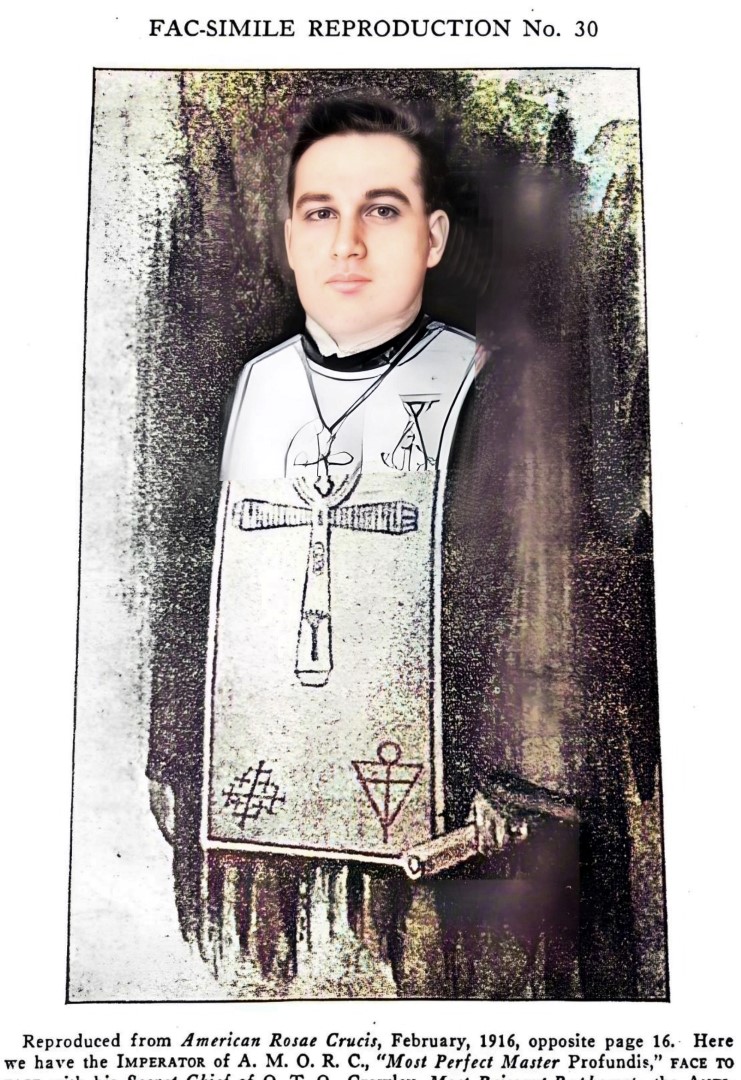
[Colored with AI] |
|
Lewis wrote to M. Carl on the 16th of February 1934, stating that Reuss
was the "secret chief of the O.T.O. and the Oriental Pansophia".
Even so, Arnoldo
Krumm-Heller's letter-headings in the 1920's bore
- amongst other titles - that of 'Societas Pansophia'.
Lewis did not immediately turn his attention to Switzerland, as stipulated on his Charter; on the contrary, he contacted Heinrich Tränker. In August 1930, the pair of them mapped out plans for a "Pansophia International Rosicrucian Council", sending out a "Second Fama" under the twin banners of the O.T.O. and A.M.O.R.C., a pastiche of the original 17th century Rosicrucian manifesto the "Fama Fraternitatis", with its mock-antique language: "come all ye hither - enter in!... 33° 90° 96° X°." Of course, this was really a crafty move on Lewis's part to legitimise the A.M.O.R.C.. [25] Initially, in 1931, Tränker's new organisation was called the 'Pansophical Rosicrucian Grand Lodge of the Griffin Gardant', then after September 19th it became the 'Pansophical Rosicrucian Lodge of the World-Tree'; but it was not to be granted a long lifespan. Soon afterwards in April 1933, Lewis made public fun of Tränker, [26] and by 1934 had set up the FUDOSI ('Federatio Universalis Dirigens Ordines Societesque Initiatices"', or sometimes FUDOESI 'Fédération Universelle Des Ordres Et Sociétés Initiatiques', which also substituted for the Église Gnostique Universelle. "The term Pansophia refers to a division of the Rosicrucian studies and work, and not as a separate school, or a separate organisation." [27]. The convening of the FUDOSI was the sole deed that underpinned Lewis's claims to Rosicrucian legitimacy for his A.M.O.R.C.. In due course it was successfully dissolved - and called on Reuben Swinburne Clymer to concur with its counter-proposal that all Rosicrucian bodies friendly to him should unite under its protection. There are exhaustive accounts of the FUDOSI in a number of French books; but here we will mention only Serge Caillet's "Sar Hieronymus" (Paris, 1986), and R.S. Clymer's own writings. ------------------ |
| In 1932 Tränker founded the 'Societas Pansophia Universalis' in New York; in mid-April 1935 publishing his "Pansophic Intellectualizer" from California and Illinois, which incorporated an article authored by G.W. Surya (1873-1949). This body's statutes and its periodical appeared under a seal of the "Universal Pansophic Society, North America - Mexico Societas Pansophia Universalis". | 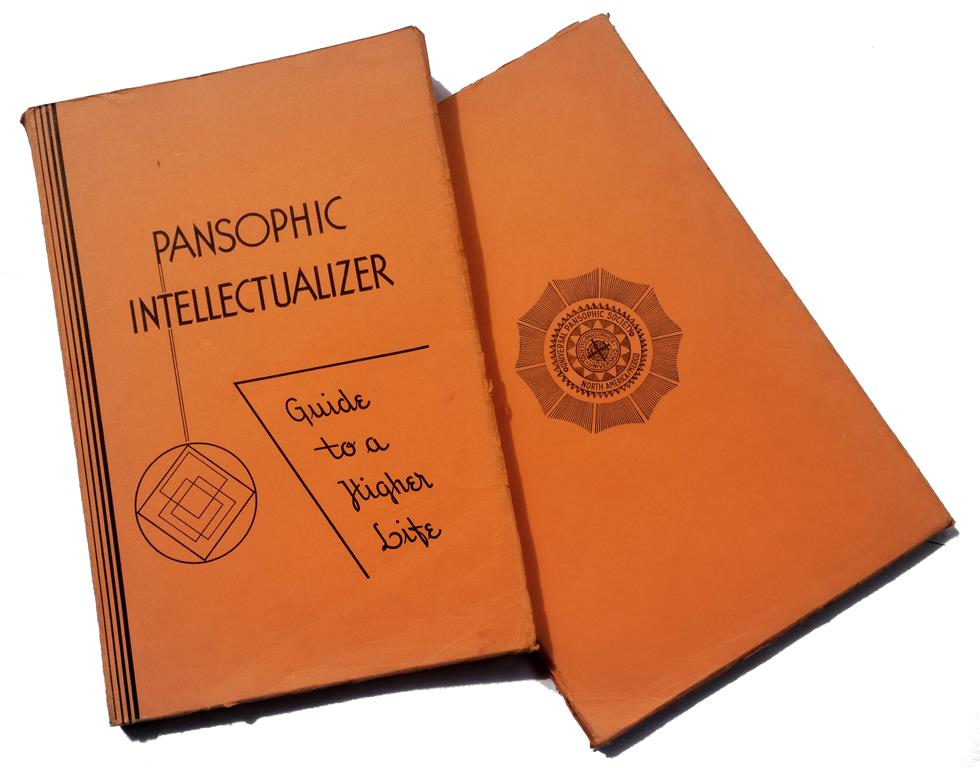
|
| The sigil is remeniscent of Reuss's SOTOM. [28] | 
|
|
Contact was maintained with C.S. Jones; Tränker translated
his most important books into German. [29] On the 1st of October 1934
Crowley expelled Jones from the O.T.O., after the latter had joined the
Roman Catholic Church, in the hope of persuading it to accept the Law
of Thelema. On the 8th of April 1948 Jones sent out "An Open Letter" in
which he proclaimed that it was "the sixth day after the Incoming of
the Aeon of Truth and Justice" (Maat and Ma-Ion); he subsequently
founded the 'Fellowship of Ma-Ion'.
Although Tränker had been legitimate Grand Master O.T.O. (X°) for Germany since 1921, Germer had a letter from Crowley (dated 1941) which named him as "Grand Master General" (X°) for the "German Speaking Peoples". Gerald Yorke, a friend of, and expert on Crowley, viewed the question of O.T.O. sovereignty thus in a letter to Germer, written on July 3rd 1948, six months after Crowley's death: "Jones and Tränker's X degrees go back to Reuss and not to A.C. They therefore in the Constitution of the O.T.O. are the ones who establish the next O.H.O., and even if you are X degree from Crowley, they can outvote you in a council to choose the new O.H.O. They could then appoint their own Treasurer General, and he could, I think, lay legal claim to the effects and the copyright." This letter would seem to explain both Germer's uncertainty over his status in the O.T.O., and H.J. Metzger's and Germer's self-restraint in Europe until after Tränker died in 1956. It confirmed that a Crowleyan O.T.O. was subordinate to a Reussian O.T.O.. [30] C.S. Jones died on the 24th of February 1950, after which Germer could breathe somewhat more freely. [31] There then appeared from Buenos Aires the Pansophic journal "From the Treasury of Knowledge and Faith". At first Metzger maintained friendly contacts with Heinrich Tränker; he obtained his address via a bookseller called Paul Dörge, from Grosche "Gregorius" himself in Berlin, at the end of July 1950. Metzger travelled post-haste to see him, since the 'Henkelkreuzmann' ('Man of the Ankh Cross') saw himself as the inheritor of Theodor Reuss's mantle, which made him into the "most serious rival". Tränker would not have known of Metzger's membership of the Fraternitas Saturni. On the one hand, the FS had been in conflict with Pansophy between 1926-8; on the other, Metzger and Grosche feared legal action, in case Tränker sued over the publication of documents, as was presumably his legal right as Supremum Sanctuarium of the O.T.O. Eventually Grosche and Metzger discussed the incorporation of the O.T.O. as 18th degree [32] into the FS, now augmented to 33 degrees, in order to protect it against Tränker. "So the Lodge [FS] stood before it [O.T.O. in Germany], and Tränker can not go against it. As an incorporated association, it had the benefit of legal protection" as 'Gregorius' commented on October 27th 1950. Metzger continued to express his hopes that 'Recnartus' in his 'pontifical' O.T.O. rôle, would eventually change his mind. Visiting Tränker, Metzger finally gained sight of the O.T.O. documents, and thereby fell out with Tränker, since he took these writings "home with me so I could 'digest' them at my leisure." without asking permission. [33] Metzger had more to fear from Tränker than Grosche. This one tried to calm down Metzger, referring to 'Recnartus' mail-order bookselling business, also possible contacts in West Berlin, Switzerland and South America (maybe with Krumm-Heller or Gabriel Montenegro?) but nevertheless declared Pansophy to be completely insignificant. Even so, in 1950 Tränker apparently had "young, intelligent, and energetic friends to hand, who are especially active where Pansophical ideas are concerned." [34] A close friend of Tränker's (and of Friedrich Lekve was Walter Studinski "Waltharius" (b. 9.11.1905), who broke away from the FS in September 1954 after six years' membership, [35] and set up the new foundation of the 'Mystical Kether Circle for the Enlightenment of All', which however soon ran into difficulties. Studinski discovered from his friend Tränker that Crowley's path was "did not aim towards God, as did the old Rosicrucian way." Via Tränker, Studinski learnt "only bad things about" Metzger. [36] In a belated response, the Swiss O.T.O. sent out a circular in early 1962, carefully distancing themselves from Grosche, the FS, Pansophy, and even Studinski [37]. Studinski retorted that "it was a matter of utter indifference to me." [38] As late as August 1964 Metzger was still insisting that Tränker could never ever have been a member of the O.T.O. [39]. After the Second World War, an engineer called Martin Erler "Albinus" (b. 24.6.1920) revived the A.M.O.R.C. in Germany. Metzger duly concocted a long-term strategy concerning the A.M.O.R.C., which he described as being one of "friendly intercourse". In 1954, Erler resigned his office as Grand Master of A.M.O.R.C., and founded the ORA (Ordo Roseae Aureae) in the Munich area with a number of interested colleagues; some members of that group had been co-members of the FS [40]. By December 16th 1959 the Munich branch of A.M.O.R.C. was in liquidation, and moved to another city.[41] During the legal proceedings in 1970 between Walter Englert's IO/O.T.O. (legally incorporated) association in Frankfurt, and Metzger over the rights to use names and titles, Englert wanted Erler to give out materials on the O.T.O. in Stein, which had supposedly ended up stored in his archives. Erler, who maintained a critical stance wherever the IO/O.T.O. was concerned, was however inclined to keep well out of the matter, and so did not involve himself in these "unseemly quarrels" [42]. |
Henry C. Birven
| Henri Clemens Birven, born on January 10th 1883 in Aachen, was a university lecturer in electrical engineering, but had originally studied philosophy in Berlin, and graduated with a dissertation on 'Kant's Transcendental Reduction'. [43] Though he lived in Berlin, he gave his nationality as "Prussian." [44] During the First World War, Birven was in a Russian prisoner-of-war camp in Siberia, but with great resourcefulness managed to escape through China, and finished up - after many adventures - back in Berlin as an assistant teacher at the Humboldtschule at Tegel. | 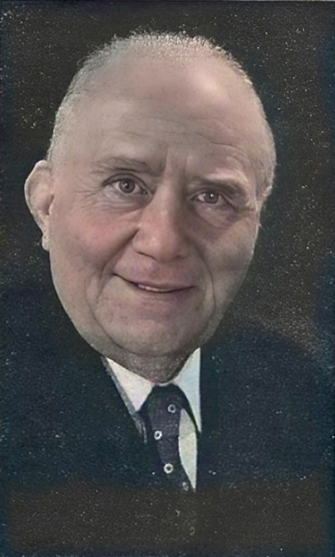
|
|
From 1927 onwards Birven produced the journal "Hain der Isis" ("Veil of
Isis"), in which (according to a contract underwritten by Martha
Küntzel on July 1st and 2nd 1929) Crowley's works were to be published.
The journal's contributors included: Gustav Meyrink (1868-1932),
Johannes Schlaf, Karl Hans Strobl, Doctor Franz Spunda, Doctor
Jules Siber, Joanny
Bricaud, Doctor E.C.H. Peithmann,
Will-Erich Peuckert, Doctor Edgar Dacqué, Willy Schlüter, and
of course, Aleister Crowley. [45]
It is said that Birven, together with Gustav Meyrink [46] and Dr. Peithmann, conducted a fruitless hunt through the streets of Nuremburg on the trail of the mysterious Fräulein Anna Sprengel, who supposedly had such a decisive part in the founding of the Golden Dawn. Meyrink (who under the alias of 'Dagobert' had become a member of Leopold Engels' Illuminati Order in 1897, [47] personally knew Carl Kellner, Heinrich Tränker, and Franz Hartmann), [48] and held little enough about Crowley. Meyrink was kept informed on the occult scene by Birven. Nonetheless he [Meyrink] followed Crowley's visit to Germany in 1925 with interest, and received a copy of the novel "Moonchild" from him via Birven, inscribed with the dedication: "To the author of "The Golem", my favourite book of its kind, with my artistic homage." [49] |
| Franz Spunda (1.1.1890-1.7.1963) was visited by Metzger at Vienna in late November 1950; Metzger received Spunda's manuscript intended for publication entitled "Magical Catechism of the noble and most learned Philosophi and Medici Philippi Theophrastus Bombasti von Hohenheim, called Paracelsus". Spunda "Sperontes", who was a member of the Metzger Illuminati Order, is known to have been at the Swiss O.T.O.'s headquarters in Stein from July 15th-20th 1955, and likewise in Zürich on August 30th 1957, and May 2nd and 9th 1961, where he delivered three lectures. | 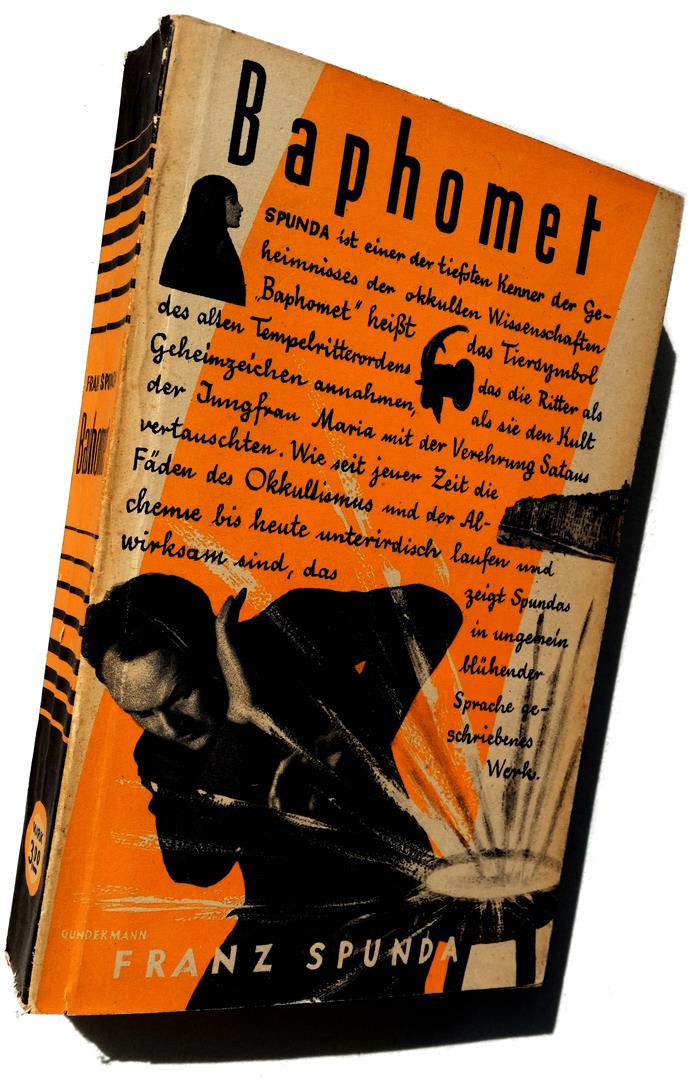
Franz Spunda: Baphomet. 1928. |
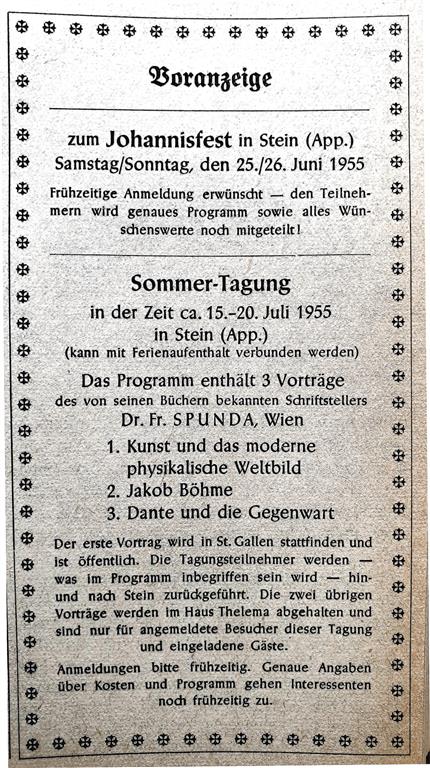
|
Karl Germer, Tränker's erstwhile secretary, and latterly the source of
Crowley's financial subsidies, nursed a number of resentments against
Birven, which undoubtedly shows his inferiority-complex as far as
Birven's overbearing personality was concerned. Germer certainly never
tired of complaining about him to Crowley: "My contact with B[irven] is not very fortunate or sympathetic. His education and knowledge, his social standing and kind of acquintances, are so far removed from a business acquintance, that he feels and manifests the fact constantly. He would not speak to me if it were not for the fact that you know me [...] B. does not want to be in touch with you or Yorke through a man like me." [50] Gerald Yorke (1901-1983) was a lifelong friend of Crowley's, and owner of the largest collection of Crowleyana in the world (now preserved at the Warburg Institute in London). Nonetheless, in 1930, it was at Birven's house in Berlin that they all met: Krumm-Heller, Germer, Gerald Yorke, and Crowley. At this point, Birven had a relatively good relationship with Tränker. Birven, who had already dismissed Reuss's ideas as a "Tutti Frutti", fell out with Crowley as a consequence. Later that year Birven was sent a 33° (Cerneau rite) warrant by Joanny Bricaud; however, he was refused to be nominated to the 95° and 96° of the MM in 1932 by Bricaud. Nevertheless Birven managed to gather a small MM-following [51] barely concealing his envy of Tränker and Krumm-Heller. In the same year Birven was prohibited any further publication of Crowley's writings in "Hain der Isis" by Crowley. Germer made the following response to the article libelling Theodor Reuss in the anti-semitic "Judenkenner" newspaper in 1936: "In the case of Birven I know that he has a tremendous literature of the background of O.T.O. etc. and was in touch with the French leading circles. He was called to the Gestapo to testify or for questioning, but I am sure not seriously molested. He [Birven] and Tränker threw it all on me, the wicked Germer. B[irven] may, to save his skin, have supplied the Gestapo with additional information, not usually found in literature." [52] According to Adolf Hemberger "Klingsor" (4.11.1929-10.11.1991), Birven was supposed to have been a member of a knightly order called the ABOAR (Authorised Brotherhood Of Ancient Rites). [53] In the 1950s, Germer warned all European Thelemites off Birven, mostly because of his published strictures against Crowley. [54] Birven had said: "All these [Crowley's writings] must be considered as inferior and wicked, because they were written under the effects of drugs. As to the so-called "Book of the Law" - which so far as is known was not written under drug-influence - that can only be described as the uncontrolled ravings of an inhuman and perverse spirit; it was supposedly a riddle even to Crowley himself." [55] After Germer's death, Birven described himself as "a particular friend of the deceased." [56] That he first found out about the existence of the Psychosophical Society (the name of Metzger's umbrella- organisation for the O.T.O., F.R.A., IO, and Gnostic Catholic Church) through Metzger's 1963 Manifesto, is hardly surprising. Supposing that Birven had actually maintained such a good relationship with Germer (like those with Crowley or Yorke), as he now so tirelessly proclaimed, surely he would have known about the existence of the Swiss O.T.O. at least, well before 1963. Oscar Schlag, who visited Birven in Berlin a year before the latter's death (9.1.1969) related how Birven boasted that he was a Grand Master of the O.T.O., waving what he claimed was Theodor Reuss's very own "Golden Book" in front of his nose - though only at a suitably safe distance, and without actually letting him read any of it. After Birven's death Metzger's "Oriflamme" suspended publication for eight months, reappearing on September 23rd 1969 with a "special issue number 95" which was to all intents and purposes nothing more than an advertising prospectus for the 'Abbey of Thelema'. Birven's estate was scattered to the four winds, and only some of his magical implements fetched up at Stein in Appenzell, while his writings and papers were supposed to have been bought up by some members of the FS. |
Karl Johannes Germer
| Born on the 22nd of January 1885 at Elberfeld, a town then near Düsseldorf and now part of the present Wuppertal, Germer had two sisters, Elisabeth and Margarete, and four brothers, Otto, Wilhelm, Gustav and Alfred. Between 1900 and 1904, he lived in London, while between 1908 and 1909 he was in the army at Dixmuiden, Lemberg, Stochod, and Armentières-Lens; he was awarded the Iron Cross both First and Second Class. [57] From 1912-14, he was the Berlin representative of Alfred Herbert Ltd. machine-tool manufacturers in Coventry; during the Great War, he was at the battle-front - first in Belgium, then as leader of a machine-gun company in Russia, finally being sent to France. | 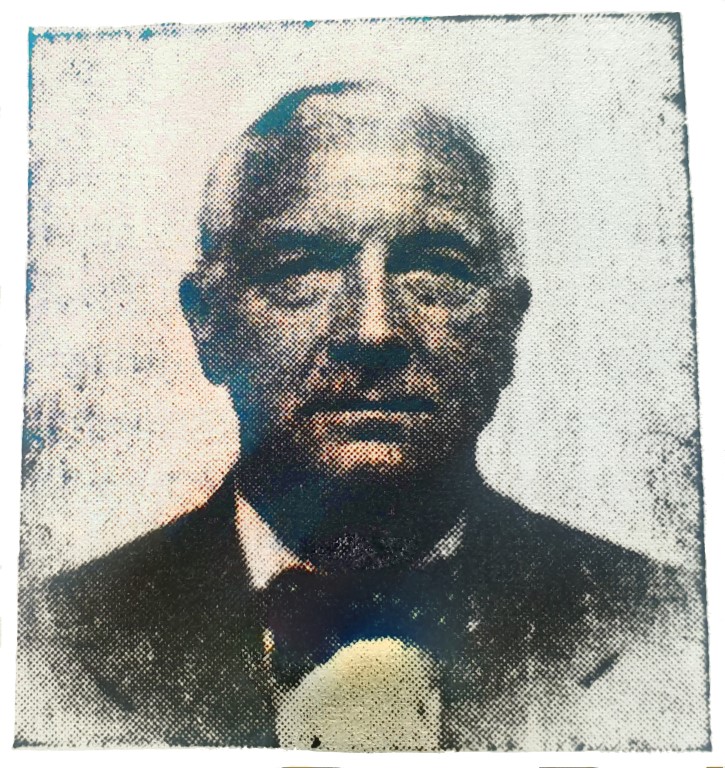
|
|
In 1919 Germer first met Heinrich Tränker in Leipzig. In 1923 Germer
sold his home in Vienna, and headed for Munich, where together with
Otto Wilhelm Barth and Tränker, he produced the journal Pansophy.
In 1925 Crowley was initially a guest at Tränker's house until the two fell out, and then went to stay with Germer; it was also during this year that Germer was a patient of the psychologist Alfred Adler in Vienna. [58] In 1926 he separated from his first wife Maria in Mexico, and on January 15th he married the wealthy Cora Eaton in New York. Back in Germany, he was arrested by the Gestapo on February 13th 1935 (Cora had stayed behind in the USA). [59] Cora and Martha Küntzel appealed to the American Embassy to intervene on his behalf, but to no avail. [60] From February to August of that year, Germer was imprisoned in a concentration camp. In October he fled to England, reaching Dublin on December 1st 1936, where he once more worked as a mechanic for a short time. In 1939-40 he wrote his long-planned book "Protective Prisoner No. 303", about his time in Esterwegen concentration camp. At the outbreak of war, Germer was living in Belgium (where he had built up an export business in machinery); he was deported thence to France on May 10th 1940, finally being permitted to emigrate to the USA on February 1st 1941. [61] Cora died on July 13th 1942. On September 23rd 1942, he married Sascha Ernestine André (b. 1891), a Viennese piano and singing teacher; she had given her singing lessons in Vienna under the name of 'Elly Aszkanasy'. Germer supported Crowley with the help of her wealth. [62] Germer's wartime experiences only served to exacerbate his paranoia; since 1942 he and Sascha became wholly convinced that their telephone was permanently tapped. Their boundless suspicions of friend and foe alike grew so bad, that for a time the couple only communicated with each other at home by means of scribbled notes. [63] Germer was in fact right to be suspicious; the FBI built up a 54-page file on him at this time. "His conversation is violent Nazi propaganda," reported one unidentified informant. Germer had apparently said "that Hitler is right in believing Germans are a 'Master Race'." [64] After Crowley's death on December 1st 1947, in default of any other claimant to the post, Germer became leader of Crowley's O.T.O. It was precisely at this time - 1947 - that Metzger inaugurated his own O.T.O. Lodge in Zürich. By 1956 Germer was living in Barstow, California, at the home of Ero Shivonen; this was where Marcelo Ramos Motta was initiated into the IX°. [65] Germer claimed that Shivonen's wife Jean had murdered her previous husband Max Schneider in 1948 [66]; he too had been one of Crowley's sources of cash. Motta thought that Crowley had been in love with Germer. However, in the concentration camp Germer's Holy Guardian Angel had appeared to him, and made plain his "passivity" to him; [67] this was the word Germer used for his ineffectual attempts at sexual advances, as Motta had discovered. [68] Maybe referring to this, one FBI source said: "I do feel something is wrong with these two men [Crowley and Germer] being in contact with each other. Mr. Crowley secured the brains behind Germer. The latter seemed to be a tool in his hands." [69] "Crowley had Syph[ilis], which he passed on to Germer." [70] Germer wrote: "O.T.O.: You must have realised that my heart and soul are not very deeply in this. A.C. knew this. He suggested to me that after his death I may either drop this form or system of working, or devise my own entirely independent method." [71] "O.T.O. does not interest me too much: mine is only the A.A. And... A.C. wanted me to set up an entirely different system." [72] The founder of the later third Agapé Lodge, 'Caliph' Grady Louis McMurtry, wished to disasociate himself from from Germer's leadership of the O.T.O., feeling only loathing for 'Saturnus'. McMurtry was so obsessed by this that even in the 1970s he was still calling Germer's authority into doubt as often as possible in his American "O.T.O. Newsletter". Germer died as a result of ineffective treatment for prostrate cancer, at five to nine on the evening of October 25th 1962 at Jackson - and left chaos behind him in his own O.T.O., and a devastated widow. His archives, which contained almost all of Crowley's manuscripts (and which - when publication proved too expensive - had to be laboriously copied out over and over again on typewriters by faithful followers like Phyllis Seckler and Jane Wolfe), later suffered several burglaries. Periodically, Germer is mistaken by doubtful researchers [73] with one Johannes Göggelmann "Saturnius" a post-office clerk from Friedrichshafen [74] and member of the Fraternitas Saturni, who wrote reams on his experiments with the demiurgus Saturn (partly published by F.W. Haack (1935 - 3.3.91) and Adolf Hemberger). [75] Such confusion caused Fräulein Äschbach (the leading light of Metzger's Swiss O.T.O.) to state that she was "most grievously" disconcerted (as quoted in the Swiss Masonic periodical "Alpina" for January 1989), and to sign herself as "Ordo Templi Orientis". |
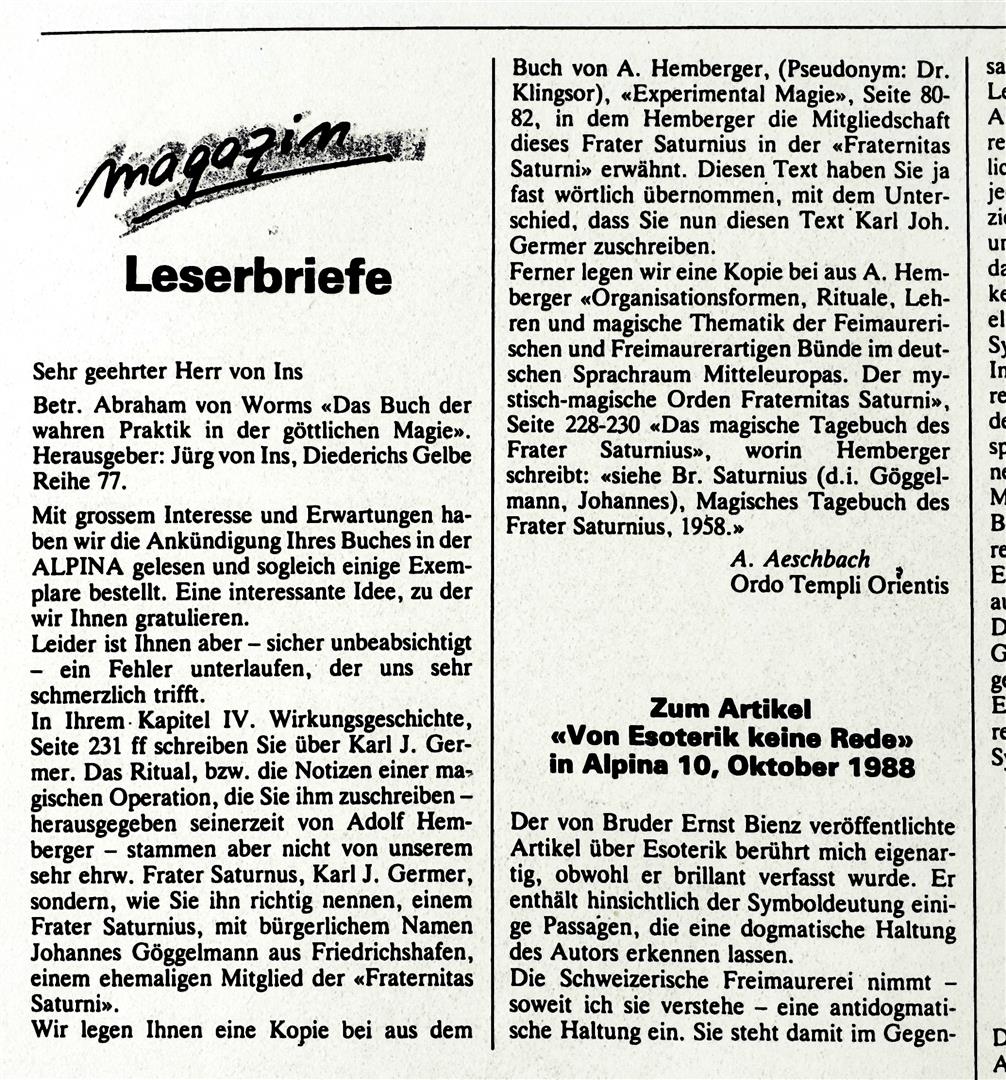
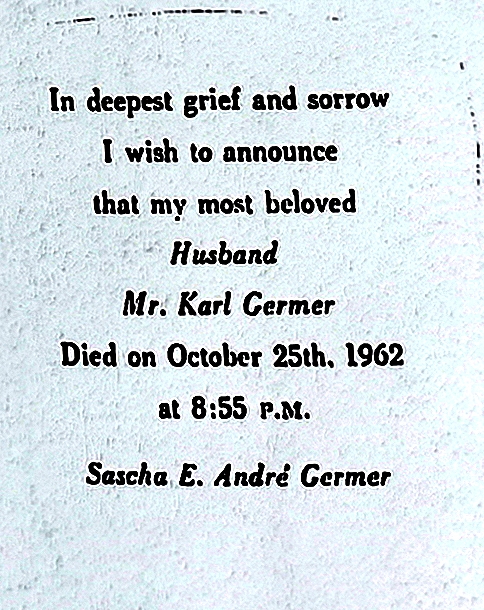
Sascha Germer's Diary about Karl Germer's death.
An Obituary on Karl Germerby Henri Clemens Birven [76] [Part II]Metzger became Swiss OHO in January 1963 and wrote an obituary in his German-English "Manifesto" on Karl Germer, the late leader of the Crowleyan O.T.O. [77] Henri Birven responded to this with a letter in which he proudly styled himself as a "particular friend of the deceased", representing himself as an expert, as "I also possess particularly valuable and voluminous correspondence of Crowley's" and "the most extensive collection of Crowley's own writings." [78] Whereas Henri Birven found fault with the "Manifesto's" English, in America the German came in for criticism: "The German part seems to have been written by a person or persons who had very little if any education, and could perhaps have been a translation from the English to German, using a dictionary and some rudimentary knowledge of German." [79] _____________ "In a certain pamphlet entitled "Manifesto", which appeared on the Spring Equinox of 1963, a biography of Karl Germer (born January 22nd 1885, died October 25th 1962), was published. The deceased was referred to by his Order name of Frater Saturnus. He was entitled 'Rex Summus Sanctissimus', a description which means 'Most Holy King', and which to my knowledge Germer never used. I [Birven] have already knew my friend Germer before he had seen Aleister Crowley in my former home at Tegel in Berlin on April 23rd 1930. Through his second marriage to an American woman, Germer became the 'rich man from the West' prophesied by Crowley. Germer then took a house in Berlin and saw me frequently. He was pleased to dine at my table, which he smilingly enjoyed very much. [...] To the best of my knowledge, Germer had studied mechanics at a German technical school, was also a mechanical engineer, but not an academically-qualified engineer. He was obviously a product of secondary education, but not university material; as far as I know, he had never practised engineering professionally. I was shocked to notice that he was only interested in certain technical books; indeed he only concerned himself with such books. Germer must have come to the end of his technical education when he was 21. The origin of the assertion that Germer completed a three-year course at the Sorbonne in Paris cannot be discovered. Germer did not understood the French conversations I conducted with Crowley [...] held while staying in France, when I told him about my French trip. I do not know whether he served as a soldier in Germany for a year; nor did he claim that he did. Nonetheless he went to Russia at the start of the war in 1914; but what use would he have been there, without knowing any Russian? Germer was not terribly fluent - even in German. I must stress here that Germer was never known as a boastful character; he was a charming and friendly man - the worst you could say about him was that he was fond of attracting wealthy women [80] - he was married three times. His first wife, a rich lady physician, Dr. Wys, certainly was far more intelligent that he was. When she grew tired of him, she used an ingenious method to get a divorce. Germer was busy working in his garden one day, when the postman gave her a letter. His wife used this as an excuse to box Germer's ears in front of the postman, after which she happily finished her cigarette. Germer's sole response was to laughing desperatedly. This way of reacting to unpleasantness was quite typical of Germer; he was never quick to act. This story comes from H. Tränker's (Recnartus's) statements, in whose house at Weida Germer once lived. It was through Tränker that Germer first really got to grips with Hermetic-Occult philosophy. "Im Vorhof des Tempels der Weisheit" ("In the Pronaos of Wisdom") by Franz Hartmann, which Tränker published, was translated from English into German by Germer. It was published as being copyright 1924 by O.W. Barth, then a resident of Munich. Germer preferred not get a mention in the book [...] After divorcing his first wife, Germer married a nice rich American lady who was much older than him. The couple stayed with me once, and I was once the Germers' guest. After this second wedding Germer was able to subsidise his Master liberally; as a consequence, the Master lived so prodigiously that Frau Germer became outraged at Crowley's spendthrift ways, saying that one fine day Crowley would be forced to face the hard facts of life, so to speak [...] On the 23rd of April 1930 Crowley, escorted by Karl Germer, appeared at what was then my home at Tegel. That evening, I made a return visit to Germer, who had found a home in Charlottenburg. Crowley's hope that my publisher Wiesicke would bring out translations of his works was not realized. Crowley then (with intermittent absences) remained for a long period in Berlin, where an exhibition of his paintings was held [...] After his second wife's death who was markedly older, he married as his third spouse Sascha E. André-Germer, who was both beautiful and had a thorough command of German - hence a valuable assistant in his literary labours. When Germer's final illness became acute, she wrote his last letters to me; he had complained to me not long before about his illness, but without realising clearly how serious it was. When they operated on his prostate it was already too late. In this letter of July 8th 1962, he told me for the first time of the result: 'Personally, I was faced with a major operation. What I at first thought was cystic catarrh was really a hardened prostate...' In one of Germer's letters dated June 13th 1961, I read [81] that he was at the Front from 1914-18, firstly in Belgium, then as commander of a machine-gun company in Russia, lastly being stationed in France, living the wretched life of retreat. In Russia he fought at the same place on the Front that I was stationed, though we did not meet each other."
|
C.H. Petersen
| Carl Heinz Peterson "Fines Transcendam / Kâlîkânanda", born on January 14th 1912 in Bendestorf near Hamburg, made contact with the European Thelemites via Karl Germer and Gerald Yorke, and founded his own 'Abbey of Thelema' in Hamburg. In February 1952 he went to meet Yorke in London. Germer wrote: "I do not at this moment wish to pass you on to somebody who would well check on your A.A. work." [82] "He seems to be near glimpsing the IX°... a man of the very highest promise!" [83] "I hope there will be a deep cooperation between you [Kenneth Grant] and P[etersen]." [84] | 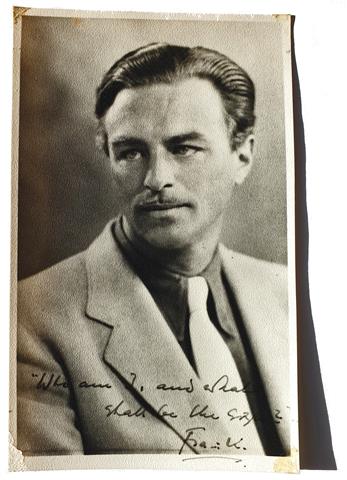 |
| In May 1953 Peterson visited the Abbey of Thelema in Stein, which Metzger considered a renewed authorisation of his IX°. However, Peterson was mainly Germer's A.·. A.·. protégé. It is still not clear why Metzger considered Peterson to be so important, when Friedrich Mellinger was Germer's European representative for the Crowleyan O.T.O.. Germer, Peterson, and soon Mellinger too, were all publishing their writings and translations through Metzger, who had bought a printing-press. The 'Psychosophical Society' was not only an umbrella-organisation for their diverse Orders, but served also as a publisher. It published "Liber AL" and the "Hymn to Pan" and C.H. Petersen privately translated Crowley's initiation rituals [85] and Yorke's "666, Sex, and the O.T.O." [86] |
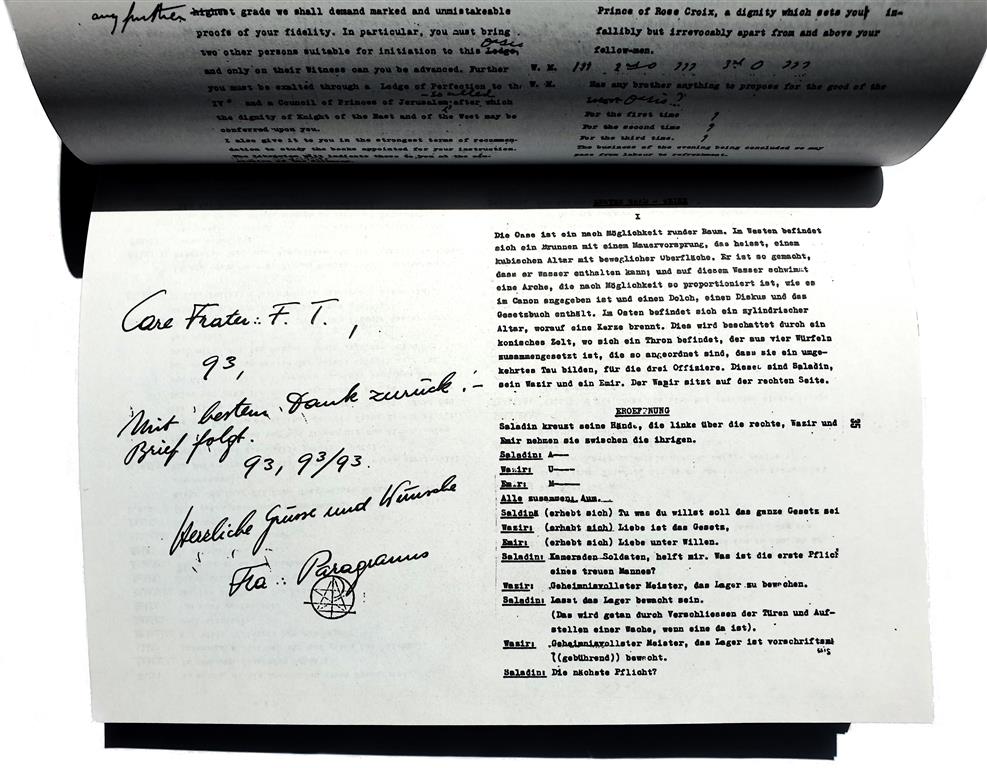
[From: 'How To Make Your Own McOTO'.]
|
In July 1953 the Swiss O.T.O. published Petersen's German translation of Crowley's "Gnostic Mass", "a free personal rendition of the English text [...] without being approved [...] and not intended for any possible practical performance," as Metzger remarked in the preface to this "Canon of the Mass". [87] The "Gnostic Mass" now used within the Swiss O.T.O. differs slightly from Petersen's twice-published translation, and also from Reuss's version of circa 1917.
Germer wrote to Petersen: "No further from Metzger about "Liber Legis": no word about financial difficulties. So I won't evoke them. Does he expect you to be responsible for the cash? I'd be very surprised. Metzger's translations: - so they were from him! I expect you have meanwhile received the ones he sent me with some corrections. - I agree with you that it is silly to operate the way he does." Germer also uttered doubts re Metzger: "It should all be concentrated in your hands," he wrote Petersen, maybe thinking of the work of translation. [88] Germer was in the dark about Mellinger's rôle in Germany, writing thus to Petersen: "I do not know whether 2 Grandmasters can operate the O.T.O. at the same time in one country (Tränker still being alive), despite the fact that A.C. appointed me Grandmaster X° of all the German-speaking peoples as far back as 1938 [1941!] or so. I have [...] such an idea [...] of setting up Headquarters in Europe, Germany, Switzerland, or... ?" The situation between Petersen and Friedrich Mellinger, Germer's delegate for O.T.O. matters in Europe, remained unresolved, [89] as did Petersen's relationship to Crowley's own nominee as his personal deputy for Europe, Friedrich Lekve. Despite Germer's aversion to Eugen Grosche Petersen started to publicise in the the Fraternitas Saturni's organ named "Blätter für angewandte okkulte Lebenskunst" (which could be rendered "Practical Occult Lifestyle News") [90], and then only secondarily by way of Metzger. In July 1954 Petersen's version of the "Gnostic Mass" appeared in Eugen Grosche's "Blätter". In August, this was followed by "Liber XLIV", and in September the "Hymn to Pan". Likewise in September 1954 the Petersen translation of "Liber Al vel Legis" appeared through Metzger, after which Germer gave Metzger "carte blanche" to undertake all future editions. In March 1955 Metzger proclaimed himself "We, the Master Therion's designated successor." That December Metzger printed his own translation of the "Gnostic Mass", in fact already published by Petersen through the Fraternitas Saturni the previous year, and grumbled in his preface that Grosche's publication was plagiarism. In the October 1955 edition of Grosche's "Blätter", there appeared an analysis of Petersen's name penned by one Hermann de Wit "Han Rulsow Yin" of Brandenburg; De Witt, a member of the FS from autumn 1950 to September 30th 1962, was later published by Metzger. When Petersen's partner in sex-magic, his cousin Frau Pingwill "Kama-Rupa, i.e. 'Lust'" committed suicide in 1956, [91] he became determined to follow her quickly, and died on April 4th 1957 at the St. Georg hospital in Hamburg. [92] Rumours were rife that Petersen had died as the result of Abra-Melin operations. [93] Since Abra-Melin's magic is limited to precise times, starting one day after Easter, and lasting "six moons", [94] it would seem that his difficulties with the system might have occurred six months after the conclusion of the final exorcism, or during the time of preparation: Easter fell on April 4th in 1956, on April 21st in 1957 - and Petersen died on the April 4th 1957. 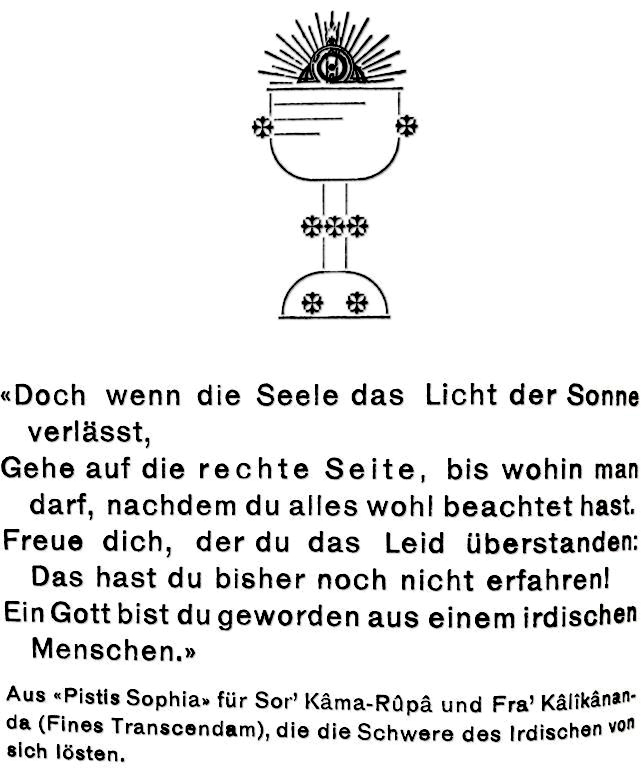
According to Metzger, both he and Friedrich Lekve (1904-1956) were named as heirs in Petersen's Will. Lekve's estate was transferred to a 'Brother Nürnberger' of Hamburg, who in turn lodged it with Metzger on October 11th 1962. The journalist Horst Knaut claimed Metzger boasted that he had "arrogated all authority to himself" after Petersen's death. [95] After the deaths of Hilfiker, Tränker, and Lekve, Metzger was the onlyIX° and X° left in continental Europe. His Lodge considered itself to be a continuation of Theodor Reuss's 'Veritas Mystica Maxima' - as "Magnus Oriens Helvetiae Veritas Mystica Maxima." The first German branch of the third Agapé Lodge (founded in 1977, the so-called 'Caliphate') was set up in 1980. It used Metzger's edition of Petersen's texts in its rituals, even while describing Metzger's publications as "illegal"; [96] thus blithely disregarding the facts that (a) Petersen was active in the 'Psychosophical Society' during his lifetime; and (b) Metzger himself published it, being authorised by Germer as "Therion's authorised successor". They photocopied Metzger's publications and blanked the original copyright notice out, substituting one of their own, justifying their actions thus: "Seriously, there are people who believe that P[etersen] never existed but was a hoax by Metzger to support his claims [to the office of the OHO., and his own translations?] to have vindicated himself" [97]. |
Roses in Austria
| Eduard Munninger "Medardus" viewed himself as the Austrian successor of the 'Fraternitas Rosicruciana Antiqua'. On the advice of Martin Erler, Munninger's assemblage of orders assumed the overall title of AAORRAC (Antiquus Arcanus Ordo Rosae Rubeae Aureae Crucis). [98] The name AAORRAC had already occured in connection with Krumm-Heller and Theodor Reuss in 1921, and was designated as the full name of the A.M.O.R.C. by Spencer Lewis: "The Rosenkreutz Order [Pansophy] in Germany was (and is) a branch of the A.A.O.R.R.A.C." [99] | 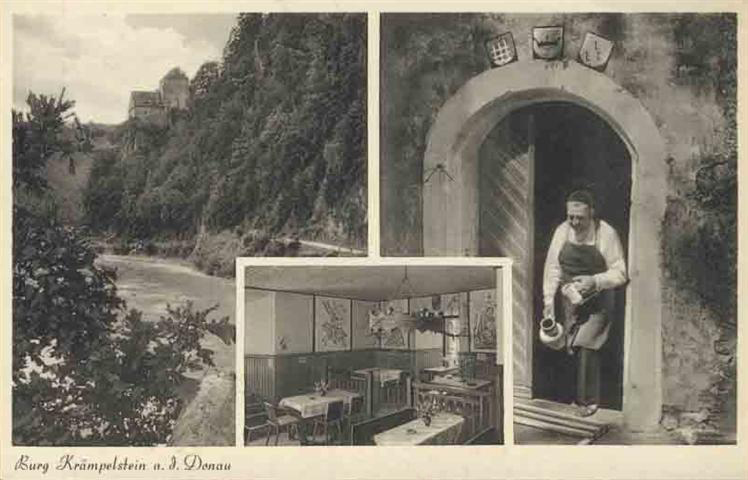
|
|
Just like Metzger, who united the leadership of various organisations
in himself, Munninger now drew the following groups together into his
collective society, the AAORRAC: the "Areopagus of the European
Culture-Circle of Chivalric Orders", the "Sovereign Order of Knights
Templar of Jerusalem",[100] the "Masonic Martinist Order of Austria",
and Tränker's "Pansophical World Federation P.W.F." [101] The Order's
journal was called "Die Burg" ("The Mountain"), referring to the
AAORRAC's address "Burg Krämpelstein", which was in fact merely an
"uninhabited ruin" at Nähe Passau in Lower Austria, as Oscar
Schlag, who liked his creature-comforts, was discomfited to discover when
he visited the place. In fact, Munninger's hotel on the mountain was
never a success.
Eduard Munninger: Roses in Austria. The successor to Arnoldo Krumm-Heller Tränker died "alone, and all the more so because he hadn't reached a decision about finding a truly spiritual heir" [102] on May 22nd 1956 (at Pankow in Berlin?). [103] In Tränker's obituary Eugen Grosche described him rather patronisingly as the "last representative of the mysticism of the Piscean Age". The idea of "Pansophical-Gnostic Rites" however lived on with Munninger. In the "Oriflamme's" 302nd issue of April 1963 Metzger made the AAORRAC and the Lectorium Rosicrucianum out to be "false Orders". Just as Metzger had once sent out circulars defaming Grosche, they appeared again denigrating Pansophy and Walter Studinski. In 1964 the Hierarch 'Medardus' employed his AAORRAC as the platform for the establishment of a 'Spiritual Culture Union'; the undertaking miscarried, and vanished after Munninger's death in 1965. Walter Englert allowed Munninger's Pansophical-Gnostic Rites to be printed in the Fraternitas Saturni's publications; [104] Haack did likewise in his series of publications. [105] Gossip at the time had it that Eduard Korbel's son had run the Illuminati Order in Vienna as a front-organisation for a certain 'Babor', independently of Metzger. After 'Babor' died in 1984, the present head of the AAORRAC, Karl Plank (a member of the 'Fama Fraternitatis' group, founded in 1954) was active in the background, also maintaining a close connection with Englert's Frankfurt-based O.T.O./IO. Since Munninger's son had inherited his father's assemblage of Orders, Plank's AAORRAC was perforce illegitimate; allegedly, the regular Viennese masonic lodges were warned against associating with Plank. Ritual material that was supposed to have derived from the "Legal and Authorised Pansophical Rosicrucian Lodge of the Shining Sun, Orient of Vienna," was privately worked in 1991, by Viennese adherents of Franz Bardon's teachings. Notes to Chapter 5 of "Das O.T.O. Phänomen", 1994
Translated and adapted from a chapter on the O.T.O. Protagonists in "Das O.T.O.-Phänomen" by Mark Parry-Maddocks. — German original online. More about Heinrich Traenker:
More about all this in: Andreas Huettl and Peter-R. Koenig: Satan - Jünger, Jäger und Justiz To the main page of Photographs and Documents To the other chapters of the English online version of "The O.T.O. Phenomenon" book O.T.O. Phenomenon navigation page | main page | mail What's New on the O.T.O. Phenomenon site? Scattered On The Floor Browsing Through The Rituals
|
